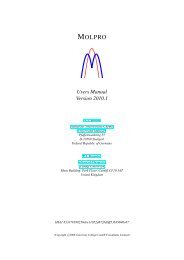Carbon−Carbon Coupling Reactions Catalyzed by Heterogeneous ...
Carbon−Carbon Coupling Reactions Catalyzed by Heterogeneous ...
Carbon−Carbon Coupling Reactions Catalyzed by Heterogeneous ...
Create successful ePaper yourself
Turn your PDF publications into a flip-book with our unique Google optimized e-Paper software.
<strong>Heterogeneous</strong> Pd <strong>Catalyzed</strong> C−C <strong>Coupling</strong> <strong>Reactions</strong> Chemical Reviews, 2007, Vol. 107, No. 1 143<br />
Table 19. Suzuki <strong>Coupling</strong>s of Aryl Halides and Arylboronic<br />
Acids <strong>Catalyzed</strong> <strong>by</strong> Fe2O3-Nanoparticle-Supported Pd-NHC<br />
Complex<br />
R 1 X R 2 yield a (%)<br />
H I 2-Me 86<br />
H I 3-Me 88<br />
H I 2-OMe 84<br />
H I 3-Ac 89<br />
H I 1-Naph 82<br />
H I 4-CN 82<br />
2-Me I H 87<br />
4-Me I H 88<br />
2-OMe I H 74<br />
4-OMe I H 83<br />
4-Ac I H 80<br />
3-Me Br H 74<br />
2-OMe Br H 70<br />
3-OMe Br H 72<br />
4-OMe Br H 78<br />
a Isolated yields; average of at least two runs.<br />
As a special feature, the recovery of this paramagnetic<br />
catalyst was facilely achieved <strong>by</strong> using a permanent magnet.<br />
Isolated catalysts were used for subsequent new rounds of<br />
reactions without significant loss of catalytic activity.<br />
Later, Gao’s group prepared another kind of magnetic<br />
maghemite (γ-Fe2O3)-silica nanoparticles where Pd was<br />
complexed via a tethered nitrogen heterocyclic carbene<br />
(Fe2O3-Si-Pd catalyst) (Figure 1). Application of this<br />
catalyst in Suzuki coupling reactions of aryl iodides or aryl<br />
bromides gave good results (Table 20). 110<br />
Figure 1. Structure of maghemite-silica nanoparticle-supported<br />
NHC Pd complex.<br />
Table 20. Maghemite-Silica-Nanoparticle-Supported<br />
Pd-<strong>Catalyzed</strong> Suzuki <strong>Reactions</strong><br />
R X<br />
GC<br />
yield (%)<br />
isolated<br />
yield (%)<br />
2-Me I 95 a 87<br />
2-Me Br 93 84<br />
2-OMe I 99 91<br />
4-Ac I 99 93<br />
a First run; the second to fifth round yield gave 94%, 95%, 93%,<br />
and 93% yield, respectively.<br />
2.2.3. Palladium-Containing Perovskites<br />
It was demonstrated that Pd-containing perovskites are a<br />
general class of heterogeneous catalysts possessing utility<br />
in cross-coupling reactions. 111 The mechanism involves the<br />
generation of soluble, catalytically active palladium species<br />
that have been desorbed from the bulk inorganic phase and<br />
will probably be re-deposited on a modified solid phase after<br />
the reaction is complete. Palladium-containing perovskites<br />
also turned out to be effective catalysts in Suzuki coupling<br />
reactions of aryl iodides and aryl bromides. 112 The catalyst<br />
could easily be recovered and reused. 113 In the case of<br />
coupling of 4-bromoanisole and phenylboronic acid, the<br />
catalyst could be used for five runs without any dedectable<br />
loss of catalytic activity (Scheme 10).<br />
Scheme 10. Recovered Pd-Perovskites-<strong>Catalyzed</strong> Suzuki<br />
<strong>Coupling</strong><br />
2.2.4. Miscellaneous Metal Oxides<br />
Recently, Hell et al. used a Pd/MgLa mixed oxide catalyst<br />
in Suzuki-Miyaura cross-coupling reactions of boronic acids<br />
with aryl halides, as well as with benzyl bromide, in ethanol<br />
using potassium carbonate or triethylamine as bases (Scheme<br />
11). 114 The catalyst could be reused several times and<br />
provided high yields also if aryl chlorides were used.<br />
Scheme 11<br />
Pd catalysts using sepiolites as solid support allowed the<br />
Suzuki reaction of iodobenzene with phenylboronic acid to<br />
be carried out without using an additional base. 57 Reusage<br />
of such catalysts was possible, however, under considerable<br />
loss of activity. The catalyst could be reactivated to a certain<br />
extent when alkali exchanged sepiolites were used.<br />
The application of a Pdx-([PW11O39] 7- )y-KF catalyst<br />
obtained <strong>by</strong> fixing Pdx-([PW11O39] 7- )y- nanoparticles on<br />
KF allowed the synthesis of biaryls 51 from aryl or heteroaryl<br />
chlorides and phenylboronic acid under solvent-free conditions<br />
in excellent yields (Scheme 12). 45<br />
Scheme 12<br />
2.3. Pd on Porous Aluminosilicates<br />
Zeolites as well-defined porous materials can be used as<br />
supports for Pd as such or in a modified manner. Pd(II) on<br />
basic zeolites was reported in the Suzuki-Miyaura coupling<br />
of bromobenzene with phenylboronic acid in toluene. 115 No<br />
leaching was observed, and the solid catalyst could be reused<br />
after washing with water. Only a minor decrease in the<br />
catalytic activity was observed.<br />
Pd(II)-NaY zeolite or Pd(0)-NaY zeolite performed very<br />
well in Suzuki reactions of aryl bromides without the addition<br />
of a ligand. 116,117 The catalysts exhibited excellent activity<br />
with K2CO3 or Na2CO3 as base at room temperature allowing<br />
high yields to be achieved after short reaction times. However<br />
they were less useful for aryl chlorides. It was found out<br />
that the coupling reactions occurred on the external surface












![Hetero [6+3] Cycloaddition of Fulvenes with N-Alkylidene Glycine ...](https://img.yumpu.com/35423358/1/190x245/hetero-6-3-cycloaddition-of-fulvenes-with-n-alkylidene-glycine-.jpg?quality=85)




